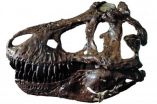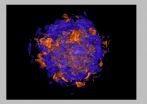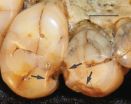(Press-News.org) We've all heard this story: the Late Cretaceous of Asia and North America—about 65 million years ago—was dominated by several large-headed, bipedal predatory dinosaurs like Tyrannosaurus rex and Tarbosaurus that had tiny arms. But a decade of new fossil discoveries that have more than doubled the number of known tyrannosaur species has changed this tale. Older and smaller tyrannosaurs have made the evolutionary tree of this group richer and more complex. Furthermore, a series of innovative research projects on topics like bone growth and biomechanics have added an enormous amount of information about tyrannosaurs, so much so that the group could now be considered an exemplar for studying many themes in paleontology research. A new paper describing recent research and a new evolutionary tree is published in Science this week.
"T. rex is the most iconic of all dinosaurs," says Mark Norell, curator in the Division of Paleontology at the American Museum of Natural History. "Its star power has allowed a research focus into questions not normally undertaken with fossils, questions like bone growth, biomechanics, and neurology."
"We know more about tyrannosaurs than any other group of dinosaurs—even more than some groups of living organisms," says Stephen Brusatte, a graduate student affiliated with the Museum and first author of the paper. "Over the past year, five new species of tyrannosaurs have been described, and over the last ten years we have found the oldest and smallest members of the group. Now we can understand the family tree of tyrannosaurs in unprecedented detail."
The Science paper combines a new analysis of tyrannosaur phylogenetics, or their genealogy, with a review of recent research into their biology. After scoring 19 well-documented tyrannosaur fossils for over 300 different traits, the researchers developed the most comprehensive evolutionary tree of this group to date. This essentially redefined tyrannosaurs, at least when compared to the popular perception of them as large meat-eaters. Tyrannosaurs have a long evolutionary history of which the largest, T. rex, Albertosaurus, and Tarbosaurus, represent species that were ecologically dominant only during the Late Cretaceous in Asia and North America. Earlier tyrannosaurs, on the other hand, lived up to 100 million years before the large apex (top) predators, which were often small in size (some one-one hundredth of the size of T. rex and akin to a lynx in body mass), and lived all over the world.
"T. rex is really just the tip of the iceberg of tyrannosaur diversity, and honestly, is quite abnormal when compared with other members of the group. For most of their evolutionary history, tyrannosaurs were small and living in the shadow of other giant apex predators," says Brusatte. "They stayed small until the end of the Cretaceous—the final 20 million years of dinosaur history."
The new paper also reviews exciting research on tyrannosaurs, including biomechanical analyses of how quickly they could run (work of co-author John Hutchinson of the Royal Veterinary College in the U.K.), how quickly they grew (work of co-author Gregory Erickson of Florida State University and Norell), demographics of the population (Erickson), and reconstructions of the brain and neurology (work of co-authors Amy Balanoff of the American Museum of Natural History and Gabe Bever of Yale University).
"The work on tyrannosaurs underscores how much can be done using modern techniques to understand the biology of fossil organisms," says Norell. "Many of us in the field now look at ourselves as biologists who just happen to work on dinosaurs."
INFORMATION:
In addition to Norell, Brusatte (who is also affiliated with Columbia University), Hutchinson, Erickson, Bever, and Balanoff, authors include Jonah Choiniere of the American Museum of Natural History, Thomas Carr of Carthage College, Peter J. Makovicky of the Field Museum, and Xing Xu of the Chinese Academy of Sciences (People's Republic of China). This research was funded by the National Science Foundation, the American Museum of Natural History, Natural Environment Research Council of the U.K., the National Natural Science Foundation of China, and Special Funds for Major State Basic Research Projects of China.
Scientific understanding of T. rex revised by a decade of new research and discovery
Tyrannosaurs are more than large carnivores at the top of the food chain
2010-09-16
ELSE PRESS RELEASES FROM THIS DATE:
Beating blood clots: Reducing your risk before hip replacement surgery
2010-09-16
Risk factors for venous thromboembolism after total hip replacement (THR) surgery were identified in a new study published in the September 2010 issue of The Journal of Bone and Joint Surgery (JBJS). While the rate of thromboembolism has been significantly reduced through medication, understanding the risk factors could further reduce the likelihood of patients developing this potentially fatal complication.
Two of the most common manifestations of a thromboembolism include:
Deep vein thrombosis (DVT), in which the blood clot forms in a deep vein, commonly in the thigh ...
Placebo effect significantly improves women's sexual satisfaction, study shows
2010-09-16
AUSTIN, Texas — Many women with low sex drives reported greater sexual satisfaction after taking a placebo, according to new psychology research from The University of Texas at Austin and Baylor College of Medicine.
The study was conducted by Cindy Meston, a clinical psychology professor at The University of Texas at Austin, and Andrea Bradford, a 2009 University of Texas at Austin graduate and postdoctoral fellow in the Department of Family and Community Medicine at Baylor College of Medicine. They found that opening a new line of communication about sex can have a positive ...
3-D computer simulations help envision supernovae explosions
2010-09-16
For scientists, supernovae are true superstars -- massive explosions of huge, dying stars that shine light on the shape and fate of the universe.
For a brief burst of time, supernovae can radiate more energy than the sun will emit in its lifetime. With the potential energy of 25 hundred trillion trillion nuclear weapons, they can outshine entire galaxies, producing some of the biggest explosions ever seen, and helping track distances across the cosmos.
Now, a Princeton-led team has found a way to make computer simulations of supernovae exploding in three dimensions, ...
Asthma and cavities both common in kids but not linked
2010-09-16
INDIANAPOLIS – There is no apparent link between asthma and tooth decay, according to a study published in the September 2010 issue of the Journal of the American Dental Association.
"Is There a Relationship between Asthma and Dental Caries?: A Critical Review of the Literature" examined the 27 separate studies which looked for a link between asthma and cavities that were reported in 29 papers published between 1976 and March 2010.
"The notion that there is a link between asthma and tooth decay may have its origin in anecdotal statements by emergency room workers who ...
Disease transmission model says media coverage cuts infection rate and pandemic extent
2010-09-16
At the first sign of a disease pandemic, public health officials should begin strongly communicating about the extent of the outbreak and the steps that can be taken by the public to avoid infection. That's the recommendation of two mathematical biologists who have modified the most widely used infectious disease transmission model to account for the impact of news media coverage.
During outbreaks of serious infectious diseases, many individuals closely follow media reports and as a result, take precautions to protect themselves against the disease. These precautions ...
October 2010 Lithosphere highlights
2010-09-16
Boulder, CO, USA – The October LITHOSPHERE examines the following key questions: (1) how do large volumes of silicic magma contribute to the growth of continental crust?; (2) how does the Tibetan Plateau grow?; (3) what are the dynamics of the lithosphere beneath the Eastern Carpathians in Romania?; (4) what's really true about the Mojave-Snow Lake fault hypothesis?; (5) can Earth's pulse be measured at its hotspots?; and (6) what is the nature of the Moho in NW Canada?
Keywords: Philipsburg Batholith, Tibetan Plateau, Carpathians, Mojave-Snow Lake fault, hotspots, Moho.
Highlights ...
A chip off the early hominin tooth
2010-09-16
Were our early mammalian ancestors vegetarians, vegans or omnivores? It's difficult for anthropologists to determine the diet of early mammalians because current fossil analysis provides too little information. But a new method that measures the size of chips in tooth fossils can help determine the kinds of foods these early humans consumed.
Prof. Herzl Chai of Tel Aviv University's School of Mechanical Engineering, in collaboration with scientists from George Washington University and the U.S. National Institute of Standards and Technology (NIST), has developed an equation ...
Undergraduate research highlighted in DNA and Cell Biology Journal
2010-09-16
New Rochelle, NY, September 16, 2010—Not only do undergraduate students gain valuable hands-on experience by participating in scientific research projects, but they also make meaningful contributions, examples of which are highlighted in the current special issue of DNA and Cell Biology, a peer-reviewed journal published by Mary Ann Liebert, Inc. The issue is available free online.
This special issue features a collection of papers reporting on successful research projects in which undergraduate students played a significant role, "and undoubtedly learned much in the ...
Bacteria identified that may lead to inflammatory bowel disease in certain individuals
2010-09-16
Certain bacteria that inhabit the intestine provide the environmental trigger that initiates and perpetuates chronic intestinal inflammation in individuals who are genetically susceptible to inflammatory bowel disease (IBD), a study led by Harvard School of Public Health researchers has found.
Inflammatory bowel disease results from a loss of homeostasis, or balance, between the immune system and the microbes that inhabit the intestine. "In this study, we identified two microbes that instigate gut inflammation that leads to inflammatory bowel disease in mice," said ...
UCSB, Texas A&M scientists document fate of deep hydrocarbon plumes in Gulf oil spill
2010-09-16
SANTA BARBARA, Calif., Sept. 16, 2010 — In the aftermath of the Deepwater Horizon disaster in the Gulf of Mexico, a team of scientists led by UC Santa Barbara's David Valentine and Texas A&M University's John Kessler embarked on a research cruise with an urgent mission: determining the fate and impact of hydrocarbon gases escaping from a deep-water oil spill.
The spill provided a rare opportunity for Valentine, a professor in the Department of Earth Science at UCSB, and Kessler, an assistant professor in the Department of Oceanography at Texas A&M, to study the behavior ...
LAST 30 PRESS RELEASES:
Magnetic avalanches power solar flares
LeapSpace goes live: the Research-Grade AI-Assisted Workspace built on trusted science
DNA tests reveal mysterious beluga family trees
Strategic sex: Alaska’s beluga whales swap mates for long-term survival
How early cell membranes may have shaped the origins of life
Cannabis legalization is driving increases in marijuana use among U.S. adults with historically lower consumption rates
Multifunctional dipoles enabling enhanced ionic and electronic transport for high‑energy batteries
Triboelectric nanogenerators for future space missions
Advancing energy development with MBene: Chemical mechanism, AI, and applications in energy storage and harvesting
Heteroatom‑coordinated Fe–N4 catalysts for enhanced oxygen reduction in alkaline seawater zinc‑air batteries
Meta-device for precision lateral displacement sensing
Plasma-guided mitotane for the treatment of adrenocortical carcinoma: adjuvant care to advanced disease
Theoretical study of laser-enhanced nuclear fusion reactions
Social environment impacts sleep quality
Optimized kinetic pathways of active hydrogen generation at Cu2O/Cu heterojunction interfaces to enhance nitrate electroreduction to ammonia
New design playbook could unlock next generation high energy lithium ion batteries
Drones reveal how feral horse units keep boundaries
New AI tool removes bottleneck in animal movement analysis
Bubble netting knowledge spread by immigrant humpback whales
Discovery of bats remarkable navigation strategy revealed in new study
Urban tributaries identified as major sources of plastic chemical pollution in the Yangtze River
UK glaucoma cases higher than expected and projected to reach 1.6 million+ by 2060
Type 2 diabetes prevention could more than halve carbon footprint linked to disease complications
Over 1 million estimated to have glaucoma in UK
Early treatment can delay rheumatoid arthritis for years
National childhood type 1 diabetes screening is effective and could prevent thousands of emergency diagnoses, UK study shows
Mix of different types of physical activity may be best for longer life
Continuous care from community-based midwives reduces risk of preterm birth by 45%
Otago experts propose fiber as first new essential nutrient in 50 years
Auburn Physics PhD student earns prestigious DOE Fellowship
[Press-News.org] Scientific understanding of T. rex revised by a decade of new research and discoveryTyrannosaurs are more than large carnivores at the top of the food chain




